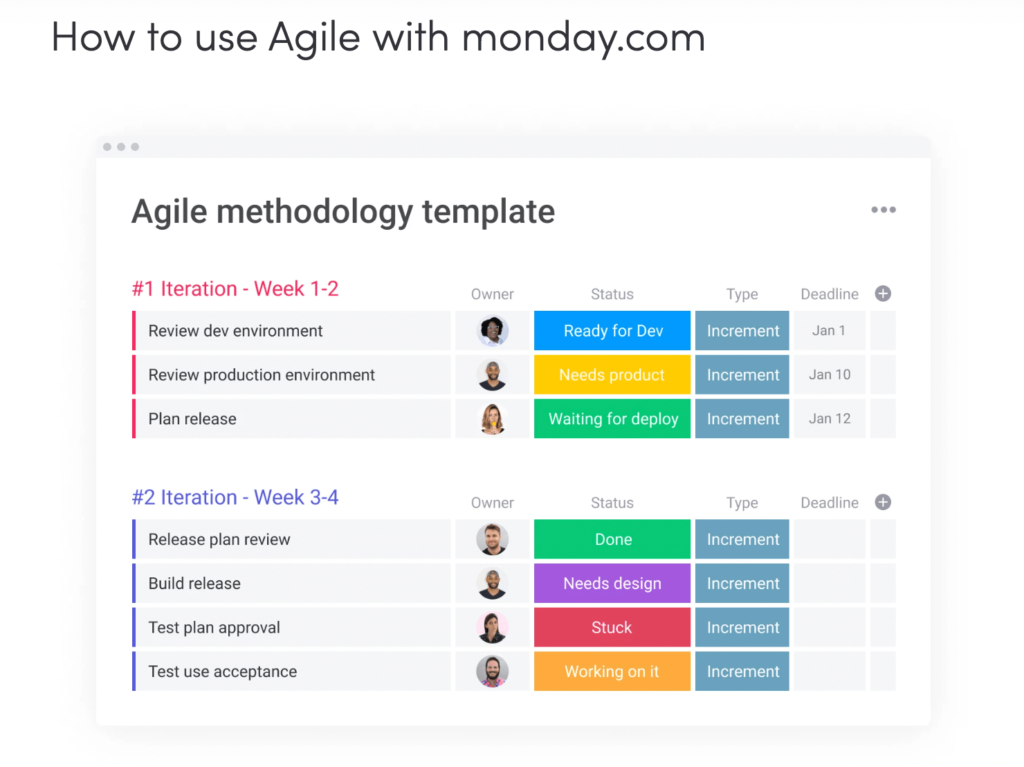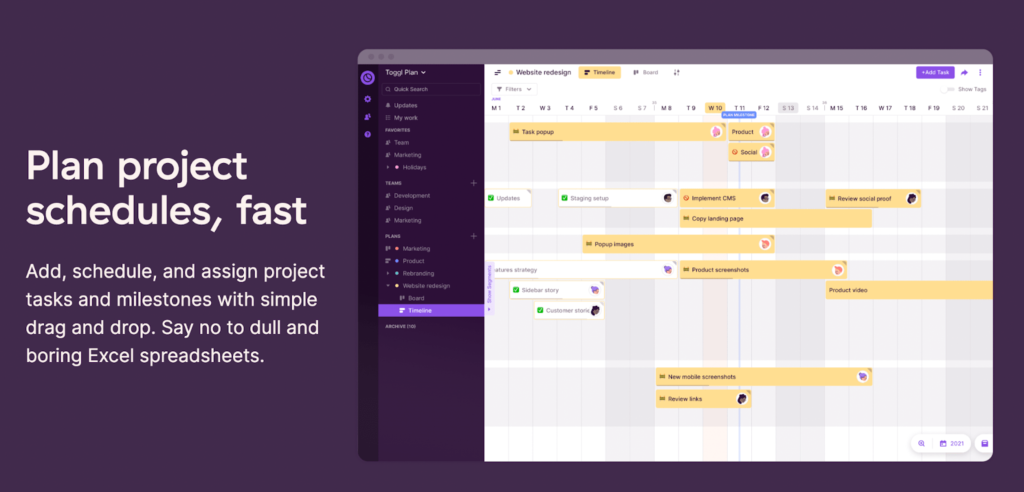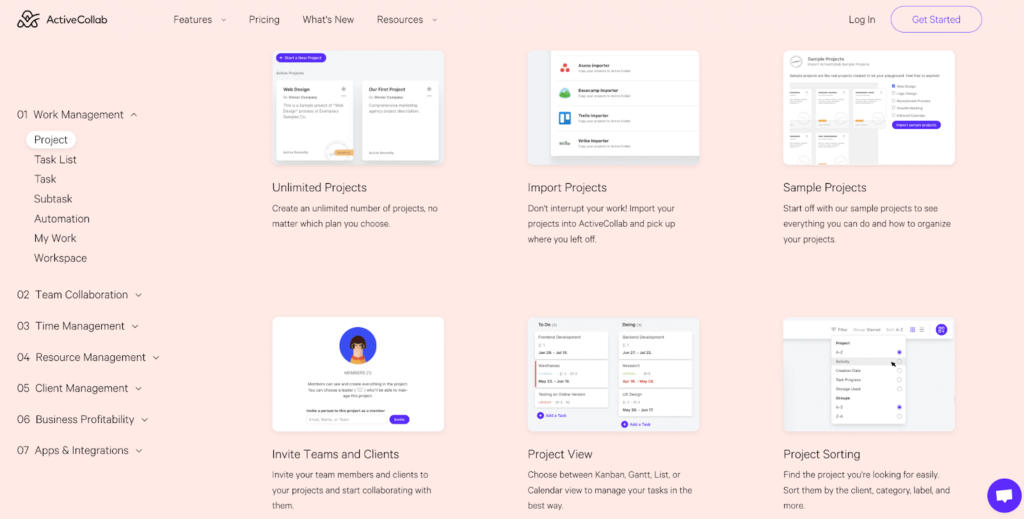Whether you’re a project leader at a software development company, a university, or a marketing agency, facing down a big project can feel overwhelming. If you dive in right away, ditching organization for the sake of saving time, you’ll probably end up swamped with what feels like an impossible amount of work.
Even worse, the people you’re completing the project for—your stakeholders—may be breathing down your neck as the deadline looms.
Using a project management methodology can help you organize your team and get the job done well. Two of the most popular project management methodologies are Agile and Waterfall. Which one should you choose for your project?
Top-Rated Software to Implement Agile Project Management
To see which tools we recommend for Agile project management, see our top list below. Many of these can also be used to implement the Waterfall methodology or a hybrid of both.
- Monday.com – Best Simple Agile Project Management Tool
- Jira Software – Best Overall Agile Project Management Tool
- Toggl Plan – Best Project Management Tool for Creative Teams
- Pivotal Tracker – Best Agile Project Management Tool for Integrations
- CollabNet VersionOne – Best Agile Project Management Tool for Scalability
- Targetprocess – Best Agile Project Management Tool for Enterprise Security
- ActiveCollab – Best Agile Project Management Tool for Time Tracking
You can read our full reviews of each project management tool here.
What Are Agile and Waterfall Project Management Methodologies?
As its name suggests, Agile methodology is flexible. Teams break tasks up into manageable sections and work on these sections at the same time, frequently collaborating with stakeholders as they work to meet short-term deadlines known as sprints.
In nature, a waterfall starts at one point and flows straight down to its destination, and that’s exactly what the Waterfall methodology does. A team gathers requirements and a final deadline date from stakeholders before planning out each step required to complete the project. The team then works on the project in a linear fashion, completing each step before beginning the next.
The Basics of Agile vs. Waterfall Methodology
The Waterfall methodology works best in fields where certain steps must be completed before others, such as building a house: if you don’t lay a foundation first, you can’t put the framing up.
Agile project management, on the other hand, excels in scenarios where multiple steps can be completed at the same time. Take a publishing house, for example, where there are multiple moving parts at all times–editing, design, layout, marketing, and more. Using an Agile methodology means the design team can work on the cover while the writer finishes revisions and the marketing team drafts a promotion plan.
Here are the three core elements that help us understand the differences between Agile vs. Waterfall project methodology.
Framework
Both methodologies take completely different approaches to organizing a project. Each has its own strengths and weaknesses, as we’ll cover below.
Agile
This project management system centers on the belief that being able to quickly pivot and adapt is critical to the success of a project. Instead of sticking to one specific framework, like Waterfall does, Agile focuses instead on four core values. Each Agile project framework, from Kanban to Scrum to Extreme Programming (XP), abides by these core values:
- Individuals and interactions over processes and tools
- A working product over exhaustive documentation
- Customer collaboration over contract negotiation
- Responding to change over following a plan
Keep in mind that processes, tools, documentation, contracts, and plans are all important in Agile, too—they’re just not the most important elements.
By design, Agile is less structured than Waterfall. This can be a downside for some. Because there are several Agile frameworks to choose from, you and your team may need to spend time learning a framework before you can begin a project.
Waterfall
Unlike Agile, Waterfall tends to follow one specific framework:
- Initiating the project
- Planning each step
- Completing each step in order
- Testing the results
- Delivering the product to the customer
This methodology places a strong focus on mapping out an entire project before the team starts working on it. Each step is carefully documented and placed into a spot according to a strict timeline.
The Waterfall system makes it easy for new team members to quickly join a project because they can read all the documentation to understand what’s required of them. However, organizing a project into a rigid framework can make fixing mistakes difficult and expensive.
If someone makes a mistake or the customer isn’t satisfied with the end result, you may have to go all the way back to the beginning and start over—often an enormously expensive and time-consuming task.
Planning
Regardless of which framework you choose for either methodology, Agile and Waterfall come with wildly different approaches to planning.
Agile
Agile methodology uses what’s called an iterative approach to project planning. Working in collaboration with the customer, a project is sorted into phases, sometimes called sprints, each with its own mini-deadline and set of deliverables. Agile uses checklists, drag-and-drop cards, templates, and other tools to help organize these project phases.
Regardless of the specific framework you choose to work with, project development and testing happen all the time in an Agile project, allowing for greater flexibility.
If the client gives you constructive criticism on a certain sprint deliverable, for example, you can adjust both the deliverable and the due date. This means you can easily make changes without derailing an entire project.
Waterfall
With Waterfall, you and your team will plan a whole project at once and organize it into steps that have to be completed in order. This can help you visualize the project and give you a solid understanding of what you need to do. It can also help keep the project moving forward smoothly, as there’s never a need to ask what needs to happen next.
On the flip side, any minor mistake or missed deadline can throw your team off track. This can cause frustration and make you lose focus as you scramble to put the plan back together after an interruption.
Communication
Now more than ever, businesses everywhere understand just how important communication is to the success of a product or project. I’m not going to lie—Agile beats Waterfall when it comes to communication. Let’s take a look.
Agile
Perhaps more than anything else, Agile focuses on listening to people—both your stakeholders and your team members. This methodology encourages you to bring customers into the whole process of creating a product, from start to finish.
Instead of holding your breath and hoping your customer will approve of the end result, you can feel confident that the project meets their standards because they’ve been there all along.
Frequent input from the customer can cause plans to change more often than you’d like, but that’s the heart of Agile project management. Ultimately, your goal is to satisfy your customer, and that’s what Agile helps you do.
Waterfall
The project stakeholder often provides input at the initial stage of a Waterfall-based project, but once the project is set and contracts are signed, the stakeholder doesn’t have much of a role. The team develops and tests the project on its own before delivering it to the customer.
This means there’s a risk that the customer won’t like the way you’ve done something. To keep them satisfied with you, your team, and your product, you may need to go back and fix an early step. This can cost a lot of time and money.
3 Tools to Improve Agile and Waterfall Project Management
Whether you want to try an Agile or Waterfall project management methodology—or you want to build your own system that incorporates elements of both—here are three tools to help you get started.
Monday.com
No matter what type of project you’re working on, Monday.com can handle it. Monday gives you control over the type of dashboard you see, and you can customize it to fit the needs of your team. Monday offers templates for both Agile and Waterfall workflows, which is part of why we love it.

Despite the flexibility and customization Monday offers, the tool is intuitive and user-friendly. It’s also GDPR compliant and has earned SOC and ISO security certifications, which means you don’t have to worry about the security of your projects and data. Plus, teams with 25 or more members can select HIPAA-compliant plans.
Toggl Plan
The more flexible your team needs to be, the more flexible Toggl Plan is. This tool offers drag-and-drop timelines to help you organize projects according to multiple due dates. Toggl Plan really shines when it comes to creative projects—think magazines with multiple stories to juggle or video streaming sites that constantly need to serve up new content.

Toggl Plan also lets you color-code milestones to help implement those sprints that Agile project management is known for.
ActiveCollab
This tool comes with a suite of features to help you organize each element of your project management strategy. Even better, ActiveCollab offers visually pleasing, UI-friendly instructions that make it easy to learn how to use said features.

Whether you want to implement a more Waterfall-oriented strategy or keep things Agile, ActiveCollab can do both. Or a hybrid of both. With ActiveCollab, it’s easy to bring both team members and clients together on any project.
3 Tricks for Agile and Waterfall Project Management
Wondering how to get started with Agile vs. Waterfall project management? These tricks can help.
Trick #1 — Determine Your Project Methodology
Everyone is different, which means that some people on your team may work better with a Waterfall methodology, while others will thrive with Agile.
If you’re just starting out, introduce both methodologies to your team. Discuss the pros and cons of each one. Collaborate with your team to figure out which methodology works best for everyone. Or, map out a plan for a hybrid of both Agile and Waterfall for your team to implement.
Trick #2 — Research the Best Tools for Your Team
Before you choose a tool like Monday.com or Toggl Plan, research their features with your team in mind. Are you more of a remote team, or do you all work together in an office? Which tool best serves your team’s particular skillset? How ready is your team to learn new software, and which software would be the most valuable for them to learn?
Our guide to the top Agile management tools—some of which can also work well with Waterfall methodology—is a great place to start, as is our guide to the best project management software.
By doing this research in advance, you’ll lower the risk of wasting valuable time learning how to use a tool that ultimately doesn’t work for you.
Trick #3 — Give Everyone Time to Learn the Methodology
Once you and your team have decided on a methodology and tool to use for a project, make sure to take the time you need to learn how to use both before you embark on a big project. Take a few days to learn your chosen methodology together using videos, blogs, and discussions between team members.
During this time, learn how to use the tool you and your team have chosen to work with by watching demos and reading how-to articles. When everyone feels knowledgeable and prepared, you can tackle projects with confidence.
What to Do Next
Even though Waterfall came first, both Agile and Waterfall have been around for decades. This means that there are tons of resources out there—and plenty more to learn. Dig deeper into Waterfall project management or discover project methodologies that go beyond both Agile and Waterfall to help you decide what could work best for you.
Reach out to other project managers in your network and ask them which methodology they use and why. By taking the time to explore project management systems, you’ll help set your team up for success no matter what project you take on.
